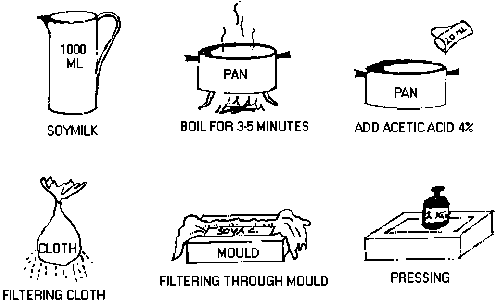Comment faire du Tofu et du lait de soja
Description brève
- Problème: nutrition à partir de sources non animales
- Idée: Pproduction de protéines d'origine végétale: le tofu et le lait de soja
- Difficulté: facile
- Gamme de prix: moins de 10 US$
- Matériel nécessaire: haricots de soja, broyeur (ou moulin manuel)
- Région géographique: globale
- Combien de personne? une
Production de tofu et de lait de soja
La technologie contre la pauvreté
Bien que la protéine se trouve dans les produits animaux (viande, lait, œufs et poissons), ces produits sont chers et dépassent souvent la capacité financière des personnes du tiers monde. Le soja est riche en valeur nutritive et constitue une alternative satisfaisante aux produits d'origine animale. Il appartient aux légumineuses à grains (aussi appelée légumes secs) et contient des protéines de bonne qualité, de l'huile, des vitamines (du groupe B) et des minéraux (fer et calcium).
La production de tofu se compose de deux étapes principales:
• la préparation du lait de soja;
• la coagulation du lait de soja pour faire du lait caillé qui sera pressé pour former des gâteaux au tofu.
Trempage du soja
Les fèves de soja sont trempées dans l'eau froide pendant la nuit ou dans de l'eau très chaude pendant 2 à 3 heures, à l'aide de 3 à 4 tasses d'eau pour chaque tasse de fèves de soja sec. Lorsque les haricots s’ouvrent facilement et sont plat à l'intérieur, ils sont prêts à être drainé. Après que l'eau soit évacuée, ils doivent être lavés à l'eau propre.
Grinding and cooking the soya beans
A grinding rock, hand mill or meat grinder can be used to grind the beans into flour. When all the beans have been ground, boiling water (for each cup of dry soya beans about 8 cups of cooking water are used) is gradually mixed to the pulp and then it is left to simmer on the fire for 20 minutes. The soymilk is stirred regularly to avoid burning.
Broyer et cuire les fèves de soja
The cooked milk is now sieved to extract the soymilk from the pulp using a filtering cloth. It is placed into a sieve which is positioned over a pot, lined with a filtering cloth. The cloth should be made from nylon or porous material - either a flour or sugar bag can be used. The sides of the cloth are held in each hand and moved up and down to roll the pulp back and forth so it forms a ball. The cloth is twisted tightly and held over a clean container while pressure is exerted onto it to extract the milk.
Soymilk
Soymilk is easily digestible and one pint of it can provide over one half of a young child’s daily protein requirement. It can be sweetened with sugar or flavoured with chocolate, cinnamon or vanilla. Salt may also be added.
Coagulating soymilk
Soymilk is heated over a fire and boiled for 3 to 5 minutes with continuous stirring. The pot is removed from the heat and a 4% acetic acid solution is added to the soymilk and stirred constantly until a good coagulum is formed. Vinegar usually contains 4% acetic acid solution and for every litre of soymilk, 2 tablespoons of vinegar are used.
Straining the curds
When large white curds can be seen floating in a clear yellow liquid, called whey, the soymilk is completely curded and ready to be filtered through a clean cloth into a suitable mould. The same method is used here as used in straining the soymilk.
To form a block of tofu, press the cloth lined tofu with a weight for about 20 minutes which will reduce its water content by approximately 60%. This can be sliced and fried or eaten plain with salt. Alternatively, the loose curds can be scrambled in a pan with onion, tomatoes and salt and served on bread.
Preservation of soymilk and tofu
Soymilk can be stored in a bottle placed in a container of cold water. However, even in cool weather, soymilk can only be kept for a day using this method.
Unseasoned block tofu should be stored under water to prevent drying out and can be kept for 2 days in moderate temperatures.
When refrigeration is available, soymilk can be kept for up to 5 days and tofu for about 10 days.
Soymilk that sours will form into curds by natural fermentation. Providing the curds are solid and not discoloured or slimy, they can be boiled for 30 to 40 minutes to kill the bacteria and made into cheese. Tofu that becomes slightly sour can also be eaten if boiled for 20 to 30 minutes.
References & useful contacts
This Howtopedia entry was derived from the Practical Action Technical Brief Tofu and Soymilk Production.
To look at the original document follow this link:
http://www.practicalaction.org/?id=technical_briefs_food_processing
• Tofu & Soymilk Production, Shurtleff, W. & Aoyagi, A.
• Small-scale and Home Processing of Soya Beans with Applications and Recipes, Loo, T.G.
• Soya - Agrodok 10, Agromisa
• Soy Demonstration Program, Plenty International
Equipment suppliers
Note: this is a selected list of suppliers and does not imply endorsement by Practical Action
Central Institute of Agricultural Engineering
Nabi Bagh
Berasia Road
Bhopal - 462 038 (M.P.)
India
Tel: +91 755 530980 - 87
Fax: +91 755 534016
• Soybean Dehuller. Capacity: 100kg/hour
• Low-cost multipurpose grainmill. Suitable for soybean Capacity: 10-70 kg/hour
• Soybean flaking machine. Capacity: 20 kg/hour
Lehman Hardware Appliances
One Lehman Circle
PO Box 41
Kidron
Ohio 44636
USA
Telephone: +1 33 857 5757
Fax: +1 33 857 5785
• Yoghurt incubator: Works with any milk including cow, soybean or goat milk. Power: Manual
Actini Parc de Montigny
Maxilly sur Leman
75500 Evian les Bains
France
Tel: +33 04 05 70 74 74
Fax: +33 04 50 70 74 75
Agrolactor. A Compact and automated platform for soya milk production.
Capacity: 250 litres/hour Power: Electric
Useful addresses
Practical Action
The Schumacher Centre for Technology & Development, Bourton on Dunsmore, RUGBY, CV23 9QZ, United Kingdom.
Tel.: +44 (0) 1926 634400, Fax: +44 (0) 1926 634401
e-mail:practicalaction@practicalaction.org.uk web:www.practicalaction.org

